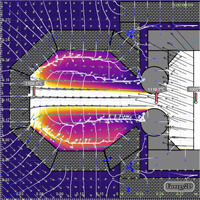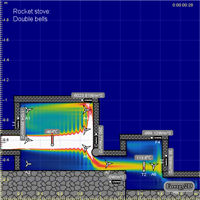 |
| Link to simulation |
A rocket mass heater is an innovative and highly efficient space heating system, which is popular among natural building DIYers since its invention in 1970s. A number of engineers who are interested in rocket stove design have used our Energy2D software to visualize the thermal physics involved.
 |
| Link to simulation |
Martin Karl Waldenburg from Germany has designed a series of simplified rocket stove simulations. With his permission, we have published his simulations on our Energy2D website. This blog post provides links to three of his simulations. Another one was created by Pinhead of the Rocket Stove Forum (who also gave us permission to publish his simulation).
 |
| Link to simulation |
 |
| Link to simulation |
Since Energy2D hasn’t supported chemical reactions yet, in all these simulations, burning is simulated using a heater with a fan to approximate the driving pressure due to combustion.
We will continue to work on Energy2D’s computational engine and improve its graphical user interface. Currently, we are plowing through the math needed to model thermal radiation, chemical reactions, and phase changes. Once these features are added, we hope more people will find it useful, educational, and entertaining.
One thought on “Engineers use Energy2D to simulate rocket mass heaters”
Comments are closed.
Are the models where combustion is represented as “heater with fan” adequate? They do not model the draft inside the stove to my understanding – they are taking it for granted, as if it magically happen due to “heater with fan”.
Should there be a pressure increase in flame other then increase that can be explained by temperature increase?